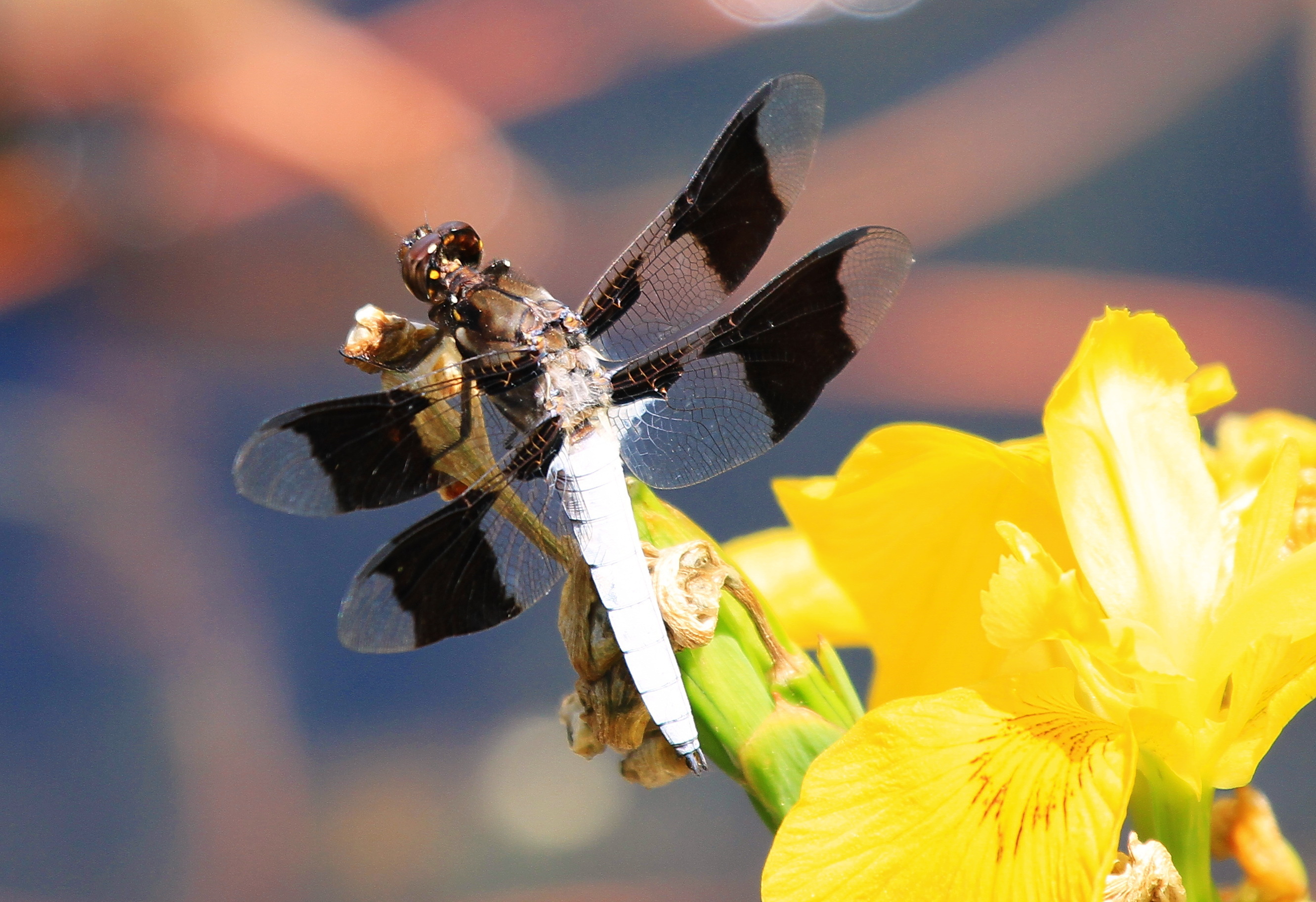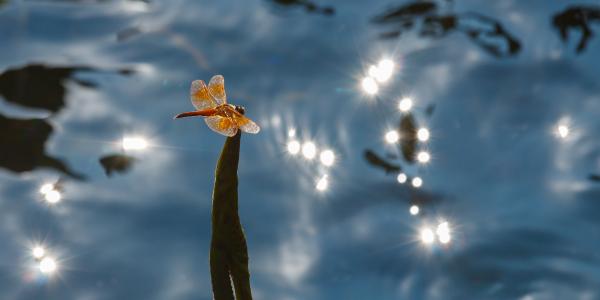One major goal in ecology and evolution research is understanding the processes by which organisms adapt to the climates in which they live. Rapid changes in climate and habitats make this goal even more urgent.

A new study in Proceedings of the National Academy of Science led by Michael Moore, a Living Earth Collaborative Post-Doctoral Fellow, evaluated if one important component of climatic adaptation is the evolution of traits that organisms use to acquire mates and reproduce. In collaboration with Kim Medley (WashU’s Tyson Research Center), Kasey Fowler-Finn (Saint Louis University) and several WashU undergraduates (Kaitlyn Hersch, Chanont Sricharoen, Sarah Lee, Caitlin Reice, Paul Rice, Sophie Kronick), the study reveals that the evolution of mating-related traits is indeed a highly predictable feature of climatic adaptation in at least one animal: dragonflies.

“Dragonflies are diverse and occupy a wide range of habitats across the world,” Moore said. “Many dragonflies have patches of dark black pigmentation on their wings which they use to court potential mates and intimidate rivals. These patches of wing pigmentation are made from melanin, and people have been using them to study mating interactions for almost fifty years. Interestingly, beyond their reproductive function, my previous research, as well as research by a few other labs throughout the world, has shown that having a bunch of dark wing pigmentation can heat dragonflies up by as much as 2 degrees Celsius, quite a big shift! In a warmer climate, the extra heat can cause tissue damage, reduction of flying ability, and potentially death. So this single trait—which is frequently essential for mating—can also significantly hinder a dragonfly’s ability to fly and survive.
“Our study examines whether or not this crucial mating trait evolves in a predictable fashion as dragonflies have adapted to climates in the past, as well as adapt to the climates they are dealing with right now.” Moore explained.
“Our study examines whether or not this crucial mating trait evolves in a predictable fashion as dragonflies have adapted to climates in the past, as well as adapt to the climates they are dealing with right now.” Moore explained.
Intriguingly, whether the researchers compared species with hotter versus cooler ranges, or compared populations of the same species that live in warmer areas versus cooler areas, they nearly always found the same pattern. Dragonfly males have consistently evolved less breeding coloration in regions with hotter climates.
These predictable patterns of evolution got the researchers wondering if dragonflies might also evolve less wing coloration as global temperatures continue to rise with climate change. Indeed, when the researchers used a large dataset of citizen-science observations of dragonflies from iNaturalist, they found that males tended to have less coloration in the hottest years from 2005 to 2019. Their projections, based on climate warming scenarios, indicate that it will be beneficial for male wing pigmentation to shrink further as the Earth warms over the next 50 years. These results suggest that one way dragonfly males may eventually need to adapt to Global Climate Change is by evolving less wing coloration.
Surprisingly, though this dark pigmentation is produced by both males and females, it seems that the ways female dragonflies are adapting to their climates has nothing to do with this mating-related trait, which leads to more questions. Moore continued: “We have some ideas about why males and females are responding differently to climate, but we don’t yet know specifically what it is that the female wing coloration is adapting to. The next goal is to learn more about differences between males and females, and figure out what is driving different responses.”
Moore notes, “Unlike the males, dragonfly females are not showing any major shifts in how their wing coloration is changing with the current climate. We know that species have different amounts of pigment on their wings that help males and females of the same species identify each other. One of the interesting implications of this research is that if male wing pigmentation evolves in response to rapid changes in climate, but female pigmentation evolves in response to something else, you might get a situation where females no longer recognize males of their own species because they no longer have this easy indicator, which could cause them to mate with males of the wrong species.
“Alternatively, if dragonfly females are evolving in response to something totally different than males, it’s possible that males might also no longer recognize females of their own species and preferentially try to mate with the wrong females. Rapid changes in mating-related traits might really hinder a species’ ability to identify the correct mate, and even though our research suggests these changes in pigmentation seem likely to happen as the world warms, the consequences are something we still don’t know much about yet,” Moore continued.
Our study shows that wing pigmentation of dragonfly males evolves so consistently in response to the climate that it’s among the most predictable evolutionary responses ever observed for a mating-related trait.
“Ultimately, researchers to date have done an awesome job identifying how plants and animals evolve their traits in order to maximize survival for the climates where they live. But many organisms need to do a lot more than just survive to perpetuate their populations and species. In many cases, they also need to coordinate mating and reproduce, yet we are just now starting to think about how organisms will need to change the way that they optimize reproduction as the world continues to warm. Our study shows that wing pigmentation of dragonfly males evolves so consistently in response to the climate that it’s among the most predictable evolutionary responses ever observed for a mating-related trait. This really emphasizes that mating-related traits can be just as important to how organisms adapt to their climates as are survival-related traits,” Moore said.
Broader implications
Many animals produce dark pigmentation associated with attracting mates. For example, a study in the early 2000’s on lions showed higher body temperatures in lions with darker manes, suggesting they may experience a potential cost associated with this mating-related trait. We also know that some plants use darker saturated colors to draw in pollinators. Does this mean that changing these mating-related traits is a consistent way plants, animals and fungi have to evolve in order to reproduce in their climate? Moore and his collaborators think so.
“It’s entirely possible that in warmer parts of North America and in warmer parts of the world, mating-related traits in both plants and animals may have often evolved to be smaller, and may continue to shrink as the Earth warms. Additionally, it’s also possible that some plants and animals may not be able to rely on dark pigmentation at all as the climate warms, because of the heating associated with darker coloration. So the loss of dark breeding coloration might be a predictable way that all organisms have to use to deal with climate change. The way that coloration absorbs light doesn’t change all that much, so the physics of light absorption may even preclude some organisms from evolving this kind of mating-related trait all together,” Moore explained.
The role of citizen science in research during pandemic times
Beyond the groundbreaking findings of their article, the researchers feel their methods hold great promise for studying ecology and evolution in the future. However, the researchers note that their reliance on these methods was largely borne out scrambling to plan research during the pandemic.
Moore had initially planned on driving around the United States during the summer of 2020, catching dragonflies, measuring their wing coloration, and taking tissue samples to look at genetic differences across the country. The pandemic disrupted this plan and forced the research team to instead rely more heavily on so-called “citizen science” to provide observations of dragonflies from across North America.
Moore noted: “When I started at WashU with the Living Earth Collaborative in August 2019, I luckily began a project with some really terrific undergraduates just to see if our wing color research could leverage citizen-science observations from this platform called iNaturalist. It immediately became obvious that our research could definitely use these photographs of dragonflies uploaded to iNaturalist to actually measure traits, and that realization came in handy once we started to understand that the pandemic was going to prevent us from doing the research that we had planned.”
Using a novel technique developed by another research group, the research team measured 2700 photographs of individual dragonflies for the amount of wing coloration on each dragonfly’s wings. Because iNaturalist stores information about the location and date of each photograph, the researchers could match up each dragonfly’s wing coloration to where and when it was observed. This allowed them to compare the pigmentation of dragonflies between hot and cold locations as well as between hot and cold years. The researchers think the methods the pandemic forced them to use could ultimately be valuable to studying geographic patterns in the traits of many kinds of plants and animals.
“What’s really cool about this new research is that we’ve been able to generate this giant database of dragonfly traits based exclusively on citizen science data—observations of dragonflies that people have been uploading to the iNaturalist site for as long as people have had cellphone cameras. Photos taken by professional scientists and amateur naturalists alike allow us to document broad scale patterns and learn something new about evolution based on publicly available data. This paper opened our eyes to clever ways we can use citizen science to answer questions in an efficient and quick manner that previously took evolutionary biologists a long time to answer,” said Moore.
This paper opened our eyes to clever ways we can use citizen science to answer questions in an efficient and quick manner that previously took evolutionary biologists a long time to answer,” said Moore.
Moving forward, the research team hopes to start collecting individual dragonflies to investigate which genes are involved in causing differences in these traits. They will take tissue samples and start sequencing their genomes, something that can’t be done through citizen science. Eventually, they want to collaborate with a network of people interested in working on discovering the genetic basis underlying the patterns they see.
Moore concluded: “Of course, citizen science won’t be perfect for every research question, even in our own research. But, even after the pandemic subsides, I suspect that there are a lot of new things that these citizen science approaches can reveal about the natural world to ecologists and evolutionary biologists.”






